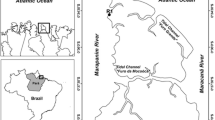Abstract
Coastal food chains have been studied mainly in relation to the structure of communities under direct or indirect changes due to human activity (pollution and fisheries). Although a great deal of information is available for the Carribbean, specially for Florida (U.S.A.), this is highly dispersed. In Snedaker (1976) a revision of the knowledge of trophic chains in Biscayne Bay is presented; Odum, Heald (1982) can be cited among others, with studies in particular environments like the trophic analysis of the mangrove community in Florida and Brook (1977) on a Thalassia testudinum community, also in Florida. An important paper which compiles a great deal of previous information is Randall (1967) on the food habits of coral reef fish. In Buesa (1969, 1970) valuable information is given on the trophic interrelations and energy flow in mangrove lagoons, Thalassia beds and the food of Lutianus synagris in Cuba. Nevertheless not much has been published on sandy beaches and sandy bottoms of littoral environments. In Venezuela the following studies on trophic relations can be cited: Edwards (1973) on sandy beaches and upper infralittoral in two oriental localities, Bastida, et al. (1977) on a coral reef of Cubagua island and Penchaszadeh (unpublished) on the food web of the benthic-demersal trawl fishing bottoms in Golfo Triste. Cervigon (1966) provides considerable information on the diet of several fishes. In the framework of an ecological study of the marine coastal environment of Punta Moron (Penchaszadeh, 1979) the trophic structure of the sandy bottom community (0–10 m depth) was studied in detail quantifying the different components of the diet of the organisms, especially that of fish related to the demersal layers and benthos. Punta Moron is of yreat interest because of Planta Centro’s thermoelectric activity.
Access this chapter
Tax calculation will be finalised at checkout
Purchases are for personal use only
Preview
Unable to display preview. Download preview PDF.
Similar content being viewed by others
References
Angelescu V (1965) Cadenas alimentarias y niveles troficos en el ecosistema marino, in Curso Av. Latinoam, de Plancton. (UNESCO) Mar del Plata, 12, 1–16.
Barnes RD (1963) Invertebrate Zoology. W.B. Sanders Co., Phil. 1–428.
Bastida R, Vervigon F and Moreno C (1977) Aspectos ecologicos de la ictiofauna de un arrecife de Acropora palmata (Isla de Cubagua, Venezuela). Res. IV Simp. Latinoam. Oceanogr. Biol., Guayaquil, 73–74.
Brook IM (1977) Trophic relationships in a seagrass community (Thalassia testudinum) in Card Sound, Florida. Fish diets in relation to macrobenthic and cryptofaunal abundance. Trans. Am. Fish. Soc. 106 (3), 219–229.
Buesa RJ (1969) La bijaiba y su trama alimentaria. Mar y Pesca, La Habana, Cuba, 54, 24–29.
Buesa RJ (1970) Energy flow at Jababo Port. Cent. Invest. Pesq. 2, pp. 1–53.
Buesa RJ (1974) Population and biological data on turtle grass (Thalassia testudinum Konig, 1805) on the northwestern cuban shelf, Aquaculture 4 (2), 207–226.
Cervigon F (1966) Los peces marinos de Venezuela. Fund. La Salle, Caracas, Vol. 1 and 2. 1–951.
Dall W (1968) Food and feeding of some Australian penaeid shrimp. Proc. World Soc. Conf. Biol. and Cult. of Shrimps and Prawns. Fish Rep. F.A.O. 57 (2), 251–258.
Darnell RM (1958) Food habits of fishes and larger invertebrates of Lake Pontchartrain, Louisiana, an estuarine community. Publ. Inst. Mar. Sci. Univ. Texas 5, 353–416.
Edwards RRC (1973) Production exology of two Caribbean Marine Ecosystems. 1. the physical environment and the fauna. Estuar. cstl. mar. Sci., 308–318.
Green J (1968) The biology of estuarine animals. Univ. of Wash. Press, Seattle, 1–401.
Hargrave BT (1970) The utilization of benthic microflora by Hyalella azteca (Amophipoda). J. Amin. Ecol. 39, 427–437.
Odum WE and de la Cruz AA (1963) Detritus as a major component of ecosystems. A.I.B.S. Bull. 13 (3), 39–40.
Odum WE and Heald EJ (1972) Trophic analysis of an estuarine mangrove community, Bull. Mar. Sci. 11 (3), 671–738.
Olivier SR, Bastida R and Torti MR (1968) sobre el ecosistema de las aguas litorales de Mar del Plata. Miveles troficos v cadenas alimentarias pelagicodemersales y bentonico denersales. Serv. Hidr. Nall. Buenos Aires, h. 1025, 1–46.
Penchaszadeh PE (1979) Ecologia del ambiente marino costero de Punta Moron, Venezuela. Ed. INTECMAR, Univ. Simon Bolivar, Caracas, 1–343.
Peres JM (1961) Oceanographie Bilogique et Biologie Marine. 1. La vie benthique. Presses Univ., Paris, 1–541.
Randall JE (1967) Food habits of reef fishes of the West Indies. Stud. Trop. Oceanogr., Miami, 5, 655–847.
Snedaker SC (1976) Ecology and the food web of Biscayne Bay. In Biscayne Bay: Present and Future. Univ. Miami Sea Grant Special Rep. No. 5, 27–233.
Wade B (1969) Studies on the biology of the West Indian beach clam, Donax denticulatus L. 3. Functional Morphology. Bull. Mar. Sci. 19, 306–322.
Author information
Authors and Affiliations
Editor information
Editors and Affiliations
Rights and permissions
Copyright information
© 1983 Springer Science+Business Media Dordrecht
About this paper
Cite this paper
Penchaszadeh, P.E. (1983). Sub-Tidal Sandy Beach Trophic Structure in the Area of Punta Moron, Venezuela. In: McLachlan, A., Erasmus, T. (eds) Sandy Beaches as Ecosystems. Developments in Hydrobiology, vol 19. Springer, Dordrecht. https://doi.org/10.1007/978-94-017-2938-3_39
Download citation
DOI: https://doi.org/10.1007/978-94-017-2938-3_39
Publisher Name: Springer, Dordrecht
Print ISBN: 978-90-481-8521-4
Online ISBN: 978-94-017-2938-3
eBook Packages: Springer Book Archive




